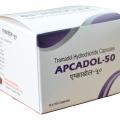Home / Categories / DOMADOL-50MG

DOMADOL-50MG
(1X10)
TRAMADOL-50MG
ANALGESIC COMBINATION (OPOIDS)
TORRENT PHARMACEUTICAL
Product Details
Tramadol Hydrochloride
Action
Indications
Contraindications
Route/Dosage
Interactions
Lab Test Interferences
Adverse Reactions
PrecautionsPatient Care Considerations
Administration/Storage
Assessment/Interventions
Patient/Family Education
(TRAM-uh-dole HIGH-droe-KLOR-ide)UltramClass: Analgesic
 Action Binds to certain opioid receptors and inhibits reuptake of norepinephrine and serotonin; exact mechanism of action unknown.
Action Binds to certain opioid receptors and inhibits reuptake of norepinephrine and serotonin; exact mechanism of action unknown.
 Indications Relief of moderate to moderately severe pain.
Indications Relief of moderate to moderately severe pain.
 Contraindications Acute intoxication with alcohol, hypnotics, centrally acting analgesics, opioids or psychotropic agents.
Contraindications Acute intoxication with alcohol, hypnotics, centrally acting analgesics, opioids or psychotropic agents.
 Route/Dosage
Route/Dosage
ADULTS & CHILDREN ³ 16 YR: PO 50–100 mg every 4–6 hr; maximum daily dose 400 mg. ELDERLY PATIENTS > 75 YR: PO 50–100 mg every 4–6 hr, maximum daily dose 300 mg. RENAL IMPAIRMENT: CRU < 30 ML/MIN. PO 50–100 mg every 12 hr (maximum 200 mg/day). CIRRHOSIS: 50 mg every 12 hours (maximum 100 mg/day).
 Interactions
Interactions
Carbamazepine: May reduce serum tramadol levels, leading to decreased effectiveness. MAO inhibitors: Risk of seizures may be increased.
 Lab Test Interferences None well documented.
Lab Test Interferences None well documented.
 Adverse Reactions
Adverse Reactions
CV: Vasodilation. CNS: Dizziness/vertigo; headache; somnolence; stimulation; anxiety; confusion; oordination disturbances; euphoria; nervousness; sleep disorder; seizures. DERM: Pruritus; sweating; rash. EENT: Visual disturbances; dry mouth. GI: Nausea; diarrhea; constipation; vomiting; dyspepsia; abdominal pain; anorexia; latulence. GU: Urinary retention/frequency; menopausal symptoms; increased creatinine; roteinuria. HEMA: Decreased hemoglobin. HEPA: Elevated liver enzymes. OTHER: Asthenia; hypertonia.
 Precautions
Precautions
Pregnancy: Category C. Lactation: Excreted in breast milk. Children: Not recommended for children < 16 yr. Elderly: Patients > 75 yr-concentrations may be slightly elevated; may have less ability to tolerate adverse effects; use reduced dosage. Head trauma: Use with caution in patients with increased intracranial pressure or head trauma. Hepatic disease: Dosage adjustments may be required in patients with cirrhosis. Renal impairment: Dosage adjustments may be required. CNS depressants: Use with caution and in reduced dosage when administering to patients receiving CNS depressants. Opioid dependence: Not recommended for patients who are opioid-dependent; use caution when administering to patients who have recently received substantial amounts of opioids.
PATIENT CARE CONSIDERATIONS
 Administration/Storage
Administration/Storage
- Can be taken without regard to meals.
- Administer medication before pain becomes severe.
- Store at room temperature, in a tightly closed container.
 Assessment/Interventions
Assessment/Interventions
- Obtain patient history.
- Assess degree, location and characteristics of pain before administering.
- Assess vital signs before administering medication. If patient is hypotensive or dyspneic, notify physician before administering.
- Monitor I&O and check for urinary retention.
- Assess the effectiveness of the medication in relieving pain.
OVERDOSAGE: SIGNS & SYMPTOMS Respiratory depression, seizures, vomiting
 Patient/Family Education
Patient/Family Education
- Instruct patient to take the prescribed dose at the recommended intervals.
- Inform patient to check with his/her healthcare provider first before taking any over-the-counter or prescription medications, including analgesics.
- Have patient report any serious side effects to the healthcare provider.
- Advise patient not to wait until pain level is high to self-medicate, because drug will not be as effective.
- Advise patient to avoid taking alcohol or other CNS depressants (g, sleeping pills).
- Advise the patient that this medication may cause drowsiness and to use caution while driving or using heavy equipment or performing other tasks requiring mental alertness.
- Advise patient to notify the healthcare provider if the pain is not relieved by the medication at the prescribed dosage.
Books@Ovid
Copyright © 2003 Facts and Comparisons
David S. Tatro
A to Z Drug Facts
Substitutes





